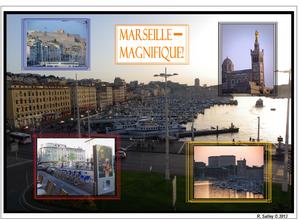Salut! Bien de te voir! (Hi, good to see you!) This “Carte Postale” (postcard) is from Marseille, the second largest city in France. At nearly a million residents, it is a vibrant, urban hive of activity. Mais non! (but no), I don’t mean Marseilles, that’s a city in Illinois! When we told our neighbors we were going to visit Marseille, everyone said that we must see “Le Vieux-Port” (the old port). We’re so glad we took their advice!
The old port was originally for goods, but these days it’s more of a pleasure port. There are cruises for tourists and so many yachts and small boats moored there, it looks like the setting for “la régate en bateau” (the boat race). High on a hill overlooking the port and the old center of the city is Notre-Dame de la Garde, a byzantine style church. Your eyes are drawn to the layer cake look of dark and light marble. (Photo 2 shows the full grandeur of this building)
The Greeks founded the city in 600 B.C. and named it Massalia. I expect there was already a settlement here, for this is where the Rhone river meets the Mediterranean Sea. The Romans put their mark on the city in 39 A.D. When they left, Visigoths took over. It wasn’t until the 6th century that France reclaimed it and over the centuries, the trade routes from here made Provence a wealthy region. Today, it is the entry point for many immigrants and the city reflects the influence of the many cultures celebrated here. You will see fashions and cuisines from Turkey, Morocco, Algeria, and Vietnam to name but a few. Renoir and Cézanne enjoyed the lively waterfront scene and we could understand why. The love of art and music is clear from the number of museums and entertainment venues. Marseille is the designated European Capital of Culture for 2013 and the city has begun a year-long celebration! (This photo shows a typical boulevard scene)
Part of the charm of this busy port is the unique culture of the “les Marseillais” – completely different from the rest of France. On our French TV, they are characterized as drinking Pastis (an anis flavored aperitif), cooking with copious amounts of olive oil and basil, crunching orange flavored biscuits, serving Olive Tapenade or Aïoli (a sauce made from garlic, eggs olive oil, and lemon juice) with almost everything and, of course, for creating a renowned seafood cuisine, including the world-famous Bouillabaisse soup. The French national anthem is La Marseillaise – the marching song of local volunteers who marched to Paris in 1792 to support the revolution. (This is one of the two harbor forts)
On this trip, we stayed in the Grand Hotel Beauvau. The room looked out on the old port and the buzz of the nightlife was invigorating. At the far end of the water were two impressive forts, Saint-Jean and Saint-Nicholas embracing the narrow opening onto the sea. Sunset from our window was amazing! (Here is the photo – sigh!) Later, we explored the boulevards looking for dinner and were spoiled for choice for there is such a variety of restaurants and cafés. We found ourselves wishing we could spend a week here just for the dining possibilities! To our French friends, Marseille is a city famous for its history of piracy. Our neighbors warned us before we set off on our trip to “Fait attention, au brigands!” but we think they meant pickpocket artists. Whatever they meant, we had no problems and wandered the night streets under starry skies without menace. We felt only good vibrations from the streams of people we met.
Our only regret is that we had just one night to spend in this vibrant port city so a return visit is on our wish list. If you want to know more, check out the city tourism web page at http://www.marseille-tourisme.com/en/. A bientôt! (see you soon). Next stop – La Camargue – and how I hope to see the white horses!
Bisous from us, R & J Salley
